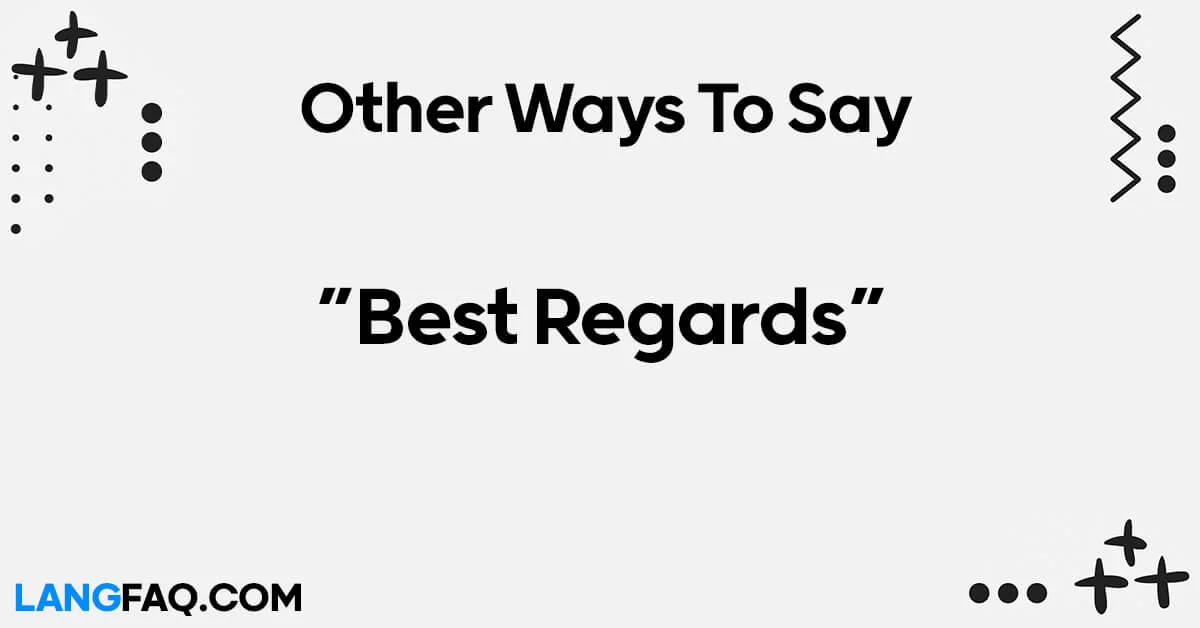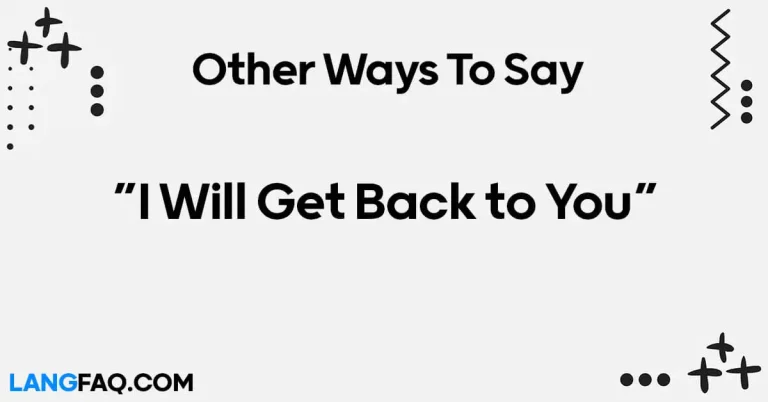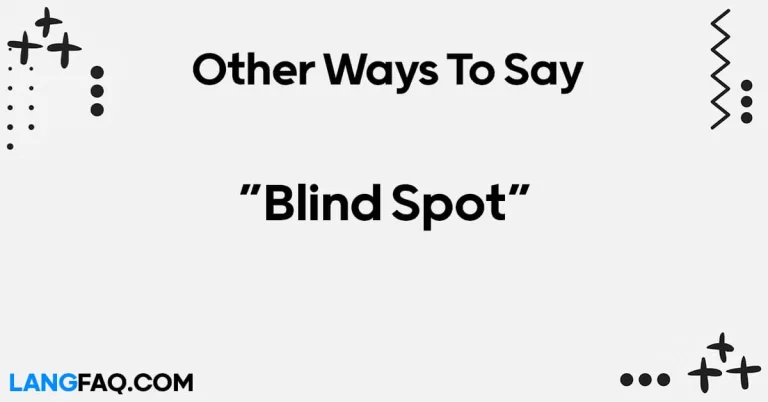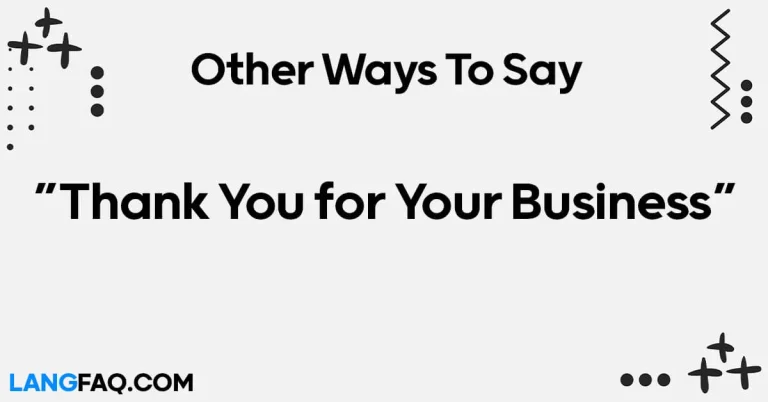In today’s fast-paced digital world, effective communication is key to success. Whether you’re closing a business deal, networking with professionals, or corresponding with colleagues, the way you end your emails leaves a lasting impression. “Best Regards” has long been a staple in email sign-offs, but adding variety to your closing can convey sincerity, warmth, and professionalism. In this comprehensive guide, we delve into 12 alternative ways to say “Best Regards,” offering insights and suggestions to elevate your professional communications.
12 Other Ways to Say “Best Regards”
Here are 12 alternative ways to say “Best Regards”:
- Warmest Regards
- Sincerely Yours
- With Appreciation
- Kind Regards
- Yours Truly
- In Appreciation
- Warm Wishes
- Many Thanks
- Cordially
- Respectfully
- With Gratitude
- All the Best
Here’s a table with the meaning and examples of 12 other ways to say “Best Regards”:
| Alternative Sign-Off | Meaning | Examples |
|---|---|---|
| Warmest Regards | Conveying heartfelt warmth and sincerity | “Warmest Regards, John” |
| Sincerely Yours | Expressing genuine sincerity and respect | “Sincerely Yours, Jane” |
| With Appreciation | Showing gratitude and acknowledgment | “With Appreciation for your assistance, David” |
| Kind Regards | Extending kindness and goodwill | “Kind Regards, Emily” |
| Yours Truly | Adding a personal touch and authenticity | “Yours Truly, Sarah” |
| In Appreciation | Recognizing value and expressing gratitude | “In Appreciation of your hard work, Michael” |
| Warm Wishes | Sending positive thoughts and well wishes | “Warm Wishes for a successful project, Anna” |
| Many Thanks | Expressing gratitude and appreciation | “Many Thanks for your support, Alex” |
| Cordially | Conveying warmth and politeness | “Cordially, Rebecca” |
| Respectfully | Showing respect and consideration | “Respectfully, Thomas” |
| With Gratitude | Expressing thanks and appreciation | “With Gratitude for your assistance, Laura” |
| All the Best | Offering good wishes and positive vibes | “All the Best in your endeavors, Mark” |
Choosing the right sign-off is essential in professional communications as it reflects your tone, sincerity, and professionalism. These alternative ways to say “Best Regards” provide a variety of options to suit different contexts and relationships, allowing you to leave a positive and lasting impression on your recipients.
Is It Correct to Say “Best Regards”?
Yes, “Best Regards” is a commonly used closing phrase in formal and professional correspondence. It is considered appropriate and polite to use in emails, letters, or other written communications, especially in business settings. “Best Regards” expresses good wishes and regards to the recipient and is often used as a polite way to conclude a message. However, it’s essential to consider the context and relationship with the recipient when choosing the closing phrase to ensure appropriateness and professionalism.
Professional Mail Example With “Best Regards”
Subject: Proposal Submission for Project XYZ
Dear [Recipient’s Name],
I hope this email finds you well. I am writing to formally submit the proposal for Project XYZ, as discussed during our recent meeting.
Our team has meticulously crafted this proposal, taking into account all the requirements and specifications outlined by your team. We believe that our solution aligns perfectly with your project goals and will deliver exceptional results.
Please find attached the detailed proposal document for your review. Should you have any questions or require further information, please do not hesitate to reach out to me directly.
Best Regards,
[Your Name] [Your Position/Title] [Your Contact Information]
Warmest Regards: Conveying Heartfelt Warmth and Sincerity
When you want to convey genuine warmth and sincerity in your email sign-off, “Warmest Regards” is an excellent choice. This phrase goes beyond the standard “Best Regards” and adds a personal touch that can leave a lasting impression on the recipient.
Meaning and Usage:
“Warmest Regards” expresses a sense of genuine warmth and sincerity towards the recipient. It conveys heartfelt wishes and genuine goodwill.
When to Use:
- Formal Context: Use “Warmest Regards” when closing emails to clients, business partners, or other professional contacts to convey genuine warmth and sincerity.
- Informal Context: It can also be used in more personal emails to friends, family, or acquaintances to express genuine warmth and well-wishes.
Example Sentence:
“Thank you for considering my proposal. Warmest Regards, [Your Name]”
Email Sample:
Subject: Follow-Up on Meeting
Dear [Recipient’s Name],
I wanted to follow up on our recent meeting and express my gratitude for your time and insights. Warmest Regards, [Your Name]
Looking forward to hearing from you soon.
Best, [Your Name]
Variations:
- For Colleagues: “Warmest Regards” can be slightly modified for colleagues to maintain professionalism while conveying warmth.
- Example: “Warmest Regards, [Your First Name]”
- For Friends: In more informal settings, you can simply use “Warm Regards” or “Warmest Wishes” to convey warmth without sounding too formal.
- Example: “Thanks for the invite! Warm Regards, [Your First Name]”
Pros:
- Conveys genuine warmth and sincerity
- Suitable for both formal and informal contexts
- Leaves a positive impression on the recipient
Cons:
- May be perceived as overly familiar in very formal settings
- Not suitable for extremely formal or strictly professional correspondences
Tips:
- Use “Warmest Regards” judiciously, reserving it for emails where genuine warmth and sincerity are appropriate.
- Pair “Warmest Regards” with a personalized message to enhance its impact and sincerity.
Conclusion:
“Warmest Regards” is a versatile and impactful sign-off that conveys genuine warmth and sincerity in professional and personal emails alike. By incorporating this phrase into your email communications, you can leave a positive and lasting impression on your recipients.
Sincerely Yours: Expressing Genuine Sincerity and Respect
“Sincerely Yours” is a classic and formal sign-off that conveys genuine sincerity and respect towards the recipient. It’s suitable for a wide range of professional and personal communications, adding a touch of professionalism and courtesy.
Meaning and Usage:
“Sincerely Yours” expresses genuine sincerity, respect, and professionalism towards the recipient. It’s a formal yet warm sign-off commonly used in business communications.
When to Use:
- Professional Context: Use “Sincerely Yours” in formal business emails, job applications, or professional correspondences to convey respect and sincerity.
- Personal Context: It can also be used in more personal emails to convey sincerity and warmth, especially when communicating with acquaintances or individuals you don’t know well.
Example Sentence:
“I appreciate your prompt response to my inquiry. Sincerely Yours, [Your Name]”
Email Sample:
Subject: Follow-Up on Project Deadline
Dear [Recipient’s Name],
I wanted to follow up on the deadline for the upcoming project. Your input and collaboration are crucial to its success. Sincerely Yours, [Your Name]
Thank you for your attention to this matter.
Best regards, [Your Name]
Variations:
- For Colleagues: “Sincerely” can be used as a more concise version for colleagues, maintaining professionalism while conveying sincerity.
- Example: “Sincerely, [Your First Name]”
- For Friends: In informal contexts, you can simply use “Sincerely” or “Yours Truly” to maintain a warm yet respectful tone.
- Example: “Thanks for the invite! Sincerely, [Your First Name]”
Pros:
- Conveys genuine sincerity and respect
- Suitable for both professional and personal communications
- Adds a touch of professionalism and courtesy to emails
Cons:
- Can come across as overly formal in very casual settings
- Not suitable for extremely informal correspondences with close friends or family members
Tips:
- Use “Sincerely Yours” when you want to convey a sense of genuine sincerity and respect towards the recipient.
- Pair “Sincerely Yours” with a personalized message to enhance its impact and sincerity, especially in professional settings.
Conclusion:
“Sincerely Yours” is a versatile and timeless sign-off that conveys genuine sincerity and respect in both professional and personal communications. By incorporating this phrase into your email sign-offs, you can convey professionalism, courtesy, and warmth to your recipients.
With Appreciation: Showing Gratitude and Acknowledgment
When you want to express gratitude and acknowledgment towards the recipient, “With Appreciation” is a thoughtful and respectful sign-off. It conveys your appreciation for their time, efforts, or assistance, fostering positive relationships.
Meaning and Usage:
“With Appreciation” expresses gratitude and acknowledgment towards the recipient. It’s a polite and respectful sign-off commonly used to thank someone for their assistance, support, or consideration.
When to Use:
- Professional Context: Use “With Appreciation” in business emails, especially when expressing gratitude towards clients, colleagues, or business partners for their contributions or assistance.
- Personal Context: It can also be used in personal emails to friends, family, or acquaintances to express gratitude for their support or kindness.
Example Sentence:
“Thank you for your valuable feedback on the project. With Appreciation, [Your Name]”
Email Sample:
Subject: Appreciation for Your Support
Dear [Recipient’s Name],
I wanted to express my heartfelt appreciation for your support during the recent project. Your insights and contributions were invaluable to its success. With Appreciation, [Your Name]
Looking forward to our continued collaboration.
Warm regards, [Your Name]
Variations:
- For Colleagues: “With Appreciation” can be used as is for colleagues, maintaining professionalism while conveying gratitude.
- Example: “With Appreciation, [Your First Name]”
- For Friends: In informal contexts, you can simply use “Appreciate It” or “Thanks” to convey gratitude in a casual manner.
- Example: “Thanks for always being there! Appreciate it, [Your First Name]”
Pros:
- Conveys genuine gratitude and acknowledgment
- Suitable for both professional and personal communications
- Fosters positive relationships by expressing appreciation
Cons:
- May be perceived as overly formal in very casual settings
- Not suitable for extremely informal correspondences with close friends or family members
Tips:
- Use “With Appreciation” when you want to express genuine gratitude and acknowledgment towards the recipient.
- Personalize your message by briefly mentioning the specific reason for your appreciation to make it more meaningful.
Conclusion:
“With Appreciation” is a thoughtful and respectful sign-off that conveys genuine gratitude and acknowledgment towards the recipient. By incorporating this phrase into your email communications, you can express appreciation and foster positive relationships with your recipients.
Kind Regards: Extending Kindness and Goodwill
“Kind Regards” is a versatile and friendly sign-off that conveys warmth and goodwill towards the recipient. It strikes a balance between formality and friendliness, making it suitable for various professional and personal correspondences.
Meaning and Usage:
“Kind Regards” expresses kindness, warmth, and goodwill towards the recipient. It’s a friendly and polite sign-off commonly used in both professional and personal emails.
When to Use:
- Professional Context: Use “Kind Regards” in business emails, especially when communicating with clients, colleagues, or business partners to convey warmth and professionalism.
- Personal Context: It can also be used in personal emails to friends, family, or acquaintances to express kindness and goodwill.
Example Sentence:
“Thank you for your prompt response. Kind Regards, [Your Name]”
Email Sample:
Subject: Invitation to Team Lunch
Dear [Recipient’s Name],
I wanted to extend an invitation to our team lunch next Friday. Your presence would be greatly appreciated. Kind Regards, [Your Name]
Looking forward to seeing you there.
Best regards, [Your Name]
Variations:
- For Colleagues: “Kind Regards” can be used as is for colleagues, maintaining a friendly yet professional tone.
- Example: “Kind Regards, [Your First Name]”
- For Friends: In informal contexts, you can simply use “Regards” or “Take Care” to maintain a casual tone.
- Example: “See you soon! Regards, [Your First Name]”
Pros:
- Conveys warmth and goodwill towards the recipient
- Strikes a balance between formality and friendliness
- Suitable for both professional and personal correspondences
Cons:
- May be perceived as overly formal in very casual settings
- Not suitable for extremely formal or strictly professional correspondences
Tips:
- Use “Kind Regards” when you want to convey warmth and goodwill towards the recipient in a friendly yet professional manner.
- Customize your message to the recipient’s personality and the context of your email to make it more personal and meaningful.
Conclusion:
“Kind Regards” is a versatile and friendly sign-off that conveys warmth and goodwill in both professional and personal emails. By incorporating this phrase into your email communications, you can strike a balance between formality and friendliness while leaving a positive impression on your recipients.
Yours Truly: Adding a Personal Touch and Authenticity
“Yours Truly” is a sign-off that adds a personal touch and authenticity to your email correspondence. It conveys a sense of sincerity and connection with the recipient, making it suitable for both professional and personal emails.
Meaning and Usage:
“Yours Truly” expresses a sense of authenticity, sincerity, and connection with the recipient. It’s a warm and personal sign-off commonly used to convey genuine regards and well-wishes.
When to Use:
- Professional Context: Use “Yours Truly” in business emails, especially when closing messages to clients, colleagues, or business partners to convey sincerity and authenticity.
- Personal Context: It can also be used in personal emails to friends, family, or acquaintances to express genuine regards and affection.
Example Sentence:
“Thank you for your support and understanding. Yours Truly, [Your Name]”
Email Sample:
Subject: Thank You for Your Assistance
Dear [Recipient’s Name],
I wanted to express my heartfelt gratitude for your assistance with the recent project. Your support was invaluable, and I truly appreciate it. Yours Truly, [Your Name]
Looking forward to our continued collaboration.
Warm regards, [Your Name]
Variations:
- For Colleagues: “Yours Truly” can be used as is for colleagues, adding a personal touch to maintain warmth and sincerity.
- Example: “Yours Truly, [Your First Name]”
- For Friends: In informal contexts, you can simply use “Truly Yours” or “Take Care” to convey sincerity and affection.
- Example: “Thanks for everything! Truly Yours, [Your First Name]”
Pros:
- Adds a personal touch and authenticity to email correspondences
- Conveys sincerity and connection with the recipient
- Suitable for both professional and personal communications
Cons:
- May be perceived as overly formal in very casual settings
- Not suitable for extremely formal or strictly professional correspondences
Tips:
- Use “Yours Truly” when you want to convey authenticity and sincerity towards the recipient in a warm and personal manner.
- Customize your message to reflect your genuine feelings and relationship with the recipient to make it more meaningful and impactful.
Conclusion:
“Yours Truly” is a warm and personal sign-off that adds authenticity and sincerity to your email correspondences. By incorporating this phrase into your communications, you can convey genuine regards and well-wishes while fostering positive relationships with your recipients.
In Appreciation: Recognizing Value and Expressing Gratitude
“In Appreciation” is a sign-off that goes beyond simple gratitude, recognizing the value of the recipient’s contributions and expressing heartfelt appreciation. It’s a thoughtful and respectful way to conclude emails, leaving a positive impression on the recipient.
Meaning and Usage:
“In Appreciation” conveys recognition of the recipient’s value and expresses sincere gratitude for their contributions or efforts. It’s a formal yet warm sign-off commonly used in professional communications.
When to Use:
- Professional Context: Use “In Appreciation” in business emails, especially when expressing gratitude towards clients, colleagues, or business partners for their valuable contributions or assistance.
- Personal Context: It can also be used in personal emails to friends, family, or acquaintances to express heartfelt appreciation for their support or kindness.
Example Sentence:
“Your dedication to this project is truly remarkable. In Appreciation, [Your Name]”
Email Sample:
Subject: Thank You for Your Support
Dear [Recipient’s Name],
I wanted to take a moment to express my sincere appreciation for your unwavering support during the recent project. Your dedication and hard work have not gone unnoticed, and I am truly grateful for your contributions. In Appreciation, [Your Name]
Looking forward to future collaborations.
Warm regards, [Your Name]
Variations:
- For Colleagues: “In Appreciation” can be used as is for colleagues to convey gratitude and recognition in a formal manner.
- Example: “In Appreciation, [Your First Name]”
- For Friends: In informal contexts, you can simply use “Appreciate It” or “Thanks a Lot” to convey gratitude in a more casual tone.
- Example: “Thanks a lot for your help! Appreciate it, [Your First Name]”
Pros:
- Conveys recognition of the recipient’s value and contributions
- Expresses heartfelt gratitude in a formal yet warm manner
- Suitable for both professional and personal communications
Cons:
- May be perceived as overly formal in very casual settings
- Not suitable for extremely informal correspondences with close friends or family members
Tips:
- Use “In Appreciation” when you want to convey sincere gratitude and recognition towards the recipient in a formal yet warm manner.
- Personalize your message by mentioning specific contributions or efforts to make the appreciation more meaningful and impactful.
Conclusion:
“In Appreciation” is a thoughtful and respectful sign-off that recognizes the value of the recipient’s contributions and expresses heartfelt gratitude. By incorporating this phrase into your email communications, you can convey genuine appreciation and foster positive relationships with your recipients.
Warm Regards: Conveying Warmth and Friendliness
“Warm Regards” is a versatile sign-off that infuses warmth and friendliness into your email communications. It creates a positive and approachable tone, making it suitable for a wide range of professional and personal correspondences.
Meaning and Usage:
Warm Regards” expresses genuine warmth and friendliness towards the recipient. It conveys a sense of approachability and positivity, fostering a positive relationship with the recipient.
When to Use:
- Professional Context: Use “Warm Regards” in business emails, especially when closing messages to clients, colleagues, or business partners to convey warmth and friendliness.
- Personal Context: It can also be used in personal emails to friends, family, or acquaintances to express warmth and affection in a casual yet sincere manner.
Example Sentence:
“I appreciate your support and cooperation. Warm Regards, [Your Name]”
Email Sample:
Subject: Invitation to Team Building Event
Dear [Recipient’s Name],
I wanted to extend an invitation to our upcoming team building event. Your presence would greatly contribute to the success of the event. Warm Regards, [Your Name]
Looking forward to your response.
Best regards, [Your Name]
Variations:
- For Colleagues: “Warm Regards” can be used as is for colleagues to maintain a friendly yet professional tone.
- Example: “Warm Regards, [Your First Name]”
- For Friends: In informal contexts, you can simply use “Warm Wishes” or “Take Care” to convey warmth and friendliness.
- Example: “Looking forward to catching up soon! Warm Wishes, [Your First Name]”
Pros:
- Conveys genuine warmth and friendliness towards the recipient
- Creates a positive and approachable tone in email communications
- Suitable for both professional and personal correspondences
Cons:
- May be perceived as overly casual in very formal settings
- Not suitable for extremely formal or strictly professional correspondences
Tips:
- Use “Warm Regards” when you want to convey warmth and friendliness towards the recipient in a positive and approachable manner.
- Pair “Warm Regards” with a personalized message to enhance its impact and sincerity, especially in professional settings.
Conclusion:
“Warm Regards” is a versatile and friendly sign-off that infuses warmth and friendliness into your email communications. By incorporating this phrase into your correspondences, you can create a positive and approachable tone while fostering positive relationships with your recipients.
Kind Regards: Conveying Kindness and Goodwill
“Kind Regards” is a versatile and friendly sign-off that conveys kindness and goodwill towards the recipient. It is a warm and respectful way to conclude your emails, leaving a positive impression on the reader.
Meaning and Usage:
Kind Regards” expresses genuine kindness and goodwill towards the recipient. It conveys a sense of warmth and friendliness, fostering positive relationships in both professional and personal contexts.
When to Use:
- Professional Context: Use “Kind Regards” in business emails, especially when closing messages to clients, colleagues, or business partners to convey kindness and respect.
- Personal Context: It can also be used in personal emails to friends, family, or acquaintances to express kindness and well-wishes in a sincere manner.
Example Sentence:
“Thank you for your assistance. Kind Regards, [Your Name]”
Email Sample:
Subject: Invitation to Dinner Party
Dear [Recipient’s Name],
I wanted to extend an invitation to our upcoming dinner party. Your presence would make the evening even more delightful. Kind Regards, [Your Name]
Looking forward to seeing you soon.
Warm regards, [Your Name]
Variations:
- For Colleagues: “Kind Regards” can be used as is for colleagues to maintain a friendly yet professional tone.
- Example: “Kind Regards, [Your First Name]”
- For Friends: In informal contexts, you can simply use “Warm Regards” or “Best Wishes” to convey kindness and well-wishes.
- Example: “Thanks for everything! Warm Regards, [Your First Name]”
Pros:
- Conveys genuine kindness and goodwill towards the recipient
- Creates a positive and respectful tone in email communications
- Suitable for both professional and personal correspondences
Cons:
- May be perceived as overly formal in very casual settings
- Not suitable for extremely formal or strictly professional correspondences
Tips:
- Use “Kind Regards” when you want to convey kindness and goodwill towards the recipient in a warm and respectful manner.
- Personalize your message to reflect your genuine feelings and relationship with the recipient to make it more meaningful and impactful.
Conclusion:
“Kind Regards” is a versatile and friendly sign-off that conveys kindness and goodwill in both professional and personal correspondences. By incorporating this phrase into your email communications, you can create a positive and respectful tone while leaving a lasting impression on your recipients.
Yours Truly: Adding a Personal Touch and Authenticity
“Yours Truly” is a sign-off that adds a personal touch and authenticity to your email correspondence. It conveys a sense of sincerity and connection with the recipient, making it suitable for both professional and personal emails.
Meaning and Usage:
“Yours Truly” expresses a sense of authenticity, sincerity, and connection with the recipient. It’s a warm and personal sign-off commonly used to convey genuine regards and well-wishes.
When to Use:
- Professional Context: Use “Yours Truly” in business emails, especially when closing messages to clients, colleagues, or business partners to convey sincerity and authenticity.
- Personal Context: It can also be used in personal emails to friends, family, or acquaintances to express genuine regards and affection.
Example Sentence:
“I appreciate your support and understanding. Yours Truly, [Your Name]”
Email Sample:
Subject: Thank You for Your Support
Dear [Recipient’s Name],
I wanted to take a moment to express my sincere appreciation for your unwavering support during the recent project. Your dedication and hard work have not gone unnoticed, and I am truly grateful for your contributions. Yours Truly, [Your Name]
Looking forward to future collaborations.
Warm regards, [Your Name]
Variations:
- For Colleagues: “Yours Truly” can be used as is for colleagues to maintain a friendly yet professional tone.
- Example: “Yours Truly, [Your First Name]”
- For Friends: In informal contexts, you can simply use “Truly Yours” or “Take Care” to convey sincerity and affection.
- Example: “Thanks for everything! Truly Yours, [Your First Name]”
Pros:
- Adds a personal touch and authenticity to email correspondences
- Conveys sincerity and connection with the recipient
- Suitable for both professional and personal communications
Cons:
- May be perceived as overly formal in very casual settings
- Not suitable for extremely formal or strictly professional correspondences
Tips:
- Use “Yours Truly” when you want to convey authenticity and sincerity towards the recipient in a warm and personal manner.
- Customize your message to reflect your genuine feelings and relationship with the recipient to make it more meaningful and impactful.
Conclusion:
“Yours Truly” is a warm and personal sign-off that adds authenticity and sincerity to your email correspondences. By incorporating this phrase into your communications, you can convey genuine regards and well-wishes while fostering positive relationships with your recipients.
In Appreciation: Recognizing Value and Expressing Gratitude
“In Appreciation” is a sign-off that goes beyond simple gratitude, recognizing the value of the recipient’s contributions and expressing heartfelt appreciation. It’s a thoughtful and respectful way to conclude emails, leaving a positive impression on the reader.
Meaning and Usage:
In Appreciation” conveys recognition of the recipient’s value and expresses sincere gratitude for their contributions or efforts. It’s a formal yet warm sign-off commonly used in professional communications.
When to Use:
- Professional Context: Use “In Appreciation” in business emails, especially when expressing gratitude towards clients, colleagues, or business partners for their valuable contributions or assistance.
- Personal Context: It can also be used in personal emails to friends, family, or acquaintances to express heartfelt appreciation for their support or kindness.
Example Sentence:
“Your dedication to this project is truly remarkable. In Appreciation, [Your Name]”
Email Sample:
Subject: Thank You for Your Support
Dear [Recipient’s Name],
I wanted to take a moment to express my sincere appreciation for your unwavering support during the recent project. Your dedication and hard work have not gone unnoticed, and I am truly grateful for your contributions. In Appreciation, [Your Name]
Looking forward to future collaborations.
Warm regards, [Your Name]
Variations:
- For Colleagues: “In Appreciation” can be used as is for colleagues to convey gratitude and recognition in a formal manner.
- Example: “In Appreciation, [Your First Name]”
- For Friends: In informal contexts, you can simply use “Appreciate It” or “Thanks a Lot” to convey gratitude in a more casual tone.
- Example: “Thanks a lot for your help! Appreciate it, [Your First Name]”
Pros:
- Conveys recognition of the recipient’s value and contributions
- Expresses heartfelt gratitude in a formal yet warm manner
- Suitable for both professional and personal communications
Cons:
- May be perceived as overly formal in very casual settings
- Not suitable for extremely informal correspondences with close friends or family members
Tips:
- Use “In Appreciation” when you want to convey sincere gratitude and recognition towards the recipient in a formal yet warm manner.
- Personalize your message by mentioning specific contributions or efforts to make the appreciation more meaningful and impactful.
Conclusion:
“In Appreciation” is a thoughtful and respectful sign-off that recognizes the value of the recipient’s contributions and expresses heartfelt appreciation. By incorporating this phrase into your email communications, you can convey genuine appreciation and foster positive relationships with your recipients.
With Gratitude: Expressing Thankfulness and Acknowledgment
“With Gratitude” is a gracious and sincere sign-off that expresses thankfulness and acknowledgment towards the recipient. It’s a heartfelt way to conclude your emails, conveying genuine appreciation and fostering positive connections.
Meaning and Usage:
With Gratitude” conveys a sense of thankfulness and acknowledgment towards the recipient. It’s a warm and respectful sign-off commonly used in both professional and personal correspondences.
When to Use:
- Professional Context: Use “With Gratitude” in business emails, especially when expressing appreciation towards clients, colleagues, or business partners for their assistance, support, or collaboration.
- Personal Context: It can also be used in personal emails to friends, family, or acquaintances to express gratitude for their kindness, support, or gestures of goodwill.
Example Sentence:
“Thank you for your guidance and support. With Gratitude, [Your Name]”
Email Sample:
Subject: Appreciation for Your Assistance
Dear [Recipient’s Name],
I wanted to extend my heartfelt thanks for your invaluable assistance during the recent project. Your expertise and support were instrumental in its success, and I am truly grateful for your contributions. With Gratitude, [Your Name]
Looking forward to future collaborations.
Warm regards, [Your Name]
Variations:
- For Colleagues: “With Gratitude” can be used as is for colleagues to convey appreciation and acknowledgment in a professional manner.
- Example: “With Gratitude, [Your First Name]”
- For Friends: In informal contexts, you can simply use “Thanks” or “Appreciate It” to convey gratitude in a more casual tone.
- Example: “Thanks a lot for your help! Appreciate it, [Your First Name]”
Pros:
- Conveys genuine thankfulness and acknowledgment towards the recipient
- Creates a warm and respectful tone in email communications
- Suitable for both professional and personal correspondences
Cons:
- May be perceived as overly formal in very casual settings
- Not suitable for extremely informal correspondences with close friends or family members
Tips:
- Use “With Gratitude” when you want to convey genuine thankfulness and acknowledgment towards the recipient in a warm and respectful manner.
- Personalize your message by mentioning specific reasons for your gratitude to make it more meaningful and impactful.
Conclusion:
“With Gratitude” is a gracious and sincere sign-off that expresses thankfulness and acknowledgment towards the recipient. By incorporating this phrase into your email communications, you can convey genuine appreciation and foster positive connections with your recipients.
Fond Regards: Expressing Warmth and Affection
“Fond Regards” is a sign-off that conveys warmth and affection towards the recipient. It’s a friendly and genuine way to conclude your emails, creating a positive and amicable tone.
Meaning and Usage:
Fond Regards” expresses genuine warmth, affection, and goodwill towards the recipient. It’s a casual yet sincere sign-off commonly used in both professional and personal correspondences.
When to Use:
- Professional Context: Use “Fond Regards” in business emails, especially when closing messages to clients, colleagues, or business partners to convey warmth and friendliness.
- Personal Context: It can also be used in personal emails to friends, family, or acquaintances to express affection and well-wishes in a sincere manner.
Example Sentence:
“I enjoyed our conversation. Fond Regards, [Your Name]”
Email Sample:
Subject: Thank You for Your Support
Dear [Recipient’s Name],
I wanted to express my sincere appreciation for your support during the recent project. Your guidance and encouragement have been invaluable, and I am truly grateful for your assistance. Fond Regards, [Your Name]
Looking forward to our continued collaboration.
Warm regards, [Your Name]
Variations:
- For Colleagues: “Fond Regards” can be used as is for colleagues to maintain a friendly and genuine tone.
- Example: “Fond Regards, [Your First Name]”
- For Friends: In informal contexts, you can simply use “Take Care” or “Best Wishes” to convey warmth and affection.
- Example: “Take care and stay in touch! Best Wishes, [Your First Name]”
Pros:
- Conveys genuine warmth and affection towards the recipient
- Creates a positive and amicable tone in email communications
- Suitable for both professional and personal correspondences
Cons:
- May be perceived as overly casual in very formal settings
- Not suitable for extremely formal or strictly professional correspondences
Tips:
- Use “Fond Regards” when you want to convey warmth and affection towards the recipient in a genuine and sincere manner.
- Pair “Fond Regards” with a personalized message to enhance its impact and sincerity, especially in personal settings.
Conclusion:
“Fond Regards” is a friendly and genuine sign-off that conveys warmth and affection towards the recipient. By incorporating this phrase into your email communications, you can create a positive and amicable tone while fostering positive connections with your recipients.
FAQs
What are the benefits of using alternative sign-offs in professional communications? By using alternative sign-offs, you can convey sincerity, warmth, and professionalism, enhancing your relationships with clients, colleagues, and business partners.
How do I choose the appropriate sign-off for my emails? Consider the tone and context of your message, as well as your relationship with the recipient. Choose a sign-off that aligns with the level of formality and the nature of your correspondence.
Can I use these alternative sign-offs in both professional and casual emails? Yes, many of these alternative sign-offs are versatile and can be used in various contexts. However, it’s essential to consider the appropriateness of the sign-off based on the nature of your relationship with the recipient.
Are there any sign-offs I should avoid in professional communications? Avoid overly informal or overly familiar sign-offs, as well as those that may be culturally insensitive or inappropriate for the context of your message.
How can I ensure my sign-offs are well-received by recipients? Tailor your sign-off to the specific recipient and situation, and always aim to convey sincerity, professionalism, and respect. Pay attention to the tone and context of your message to ensure your sign-off is appropriate.
Is it necessary to include a sign-off in every email? While sign-offs are generally considered a polite way to conclude an email, they may not always be necessary, particularly in brief or informal exchanges. Use your judgment to determine when a sign-off is appropriate.
Conclusion
Enhancing your professional communications begins with thoughtful and considerate email sign-offs. By incorporating these 12 alternative ways to say “Best Regards,” you can convey sincerity, warmth, and professionalism in your correspondence, strengthening your relationships and leaving a positive impression on recipients.







